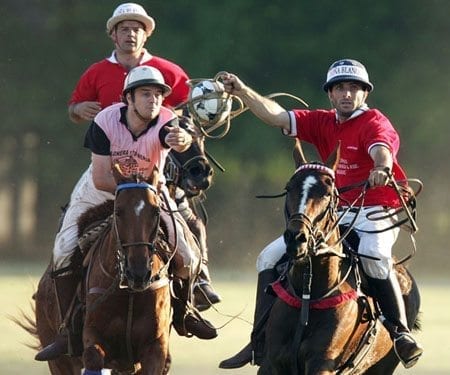In a world that is full of video games and portable computers, the younger generations often have to wonder what people did “in the old days” to entertain themselves. Reading books is a common thought. Playing dominoes, perhaps. Or maybe tossing a duck in a basket and seeing which of two teams can carry it to their goal first. That seems normal.
And here in Argentina, it was perfectly normal just a few short centuries ago! This game, known as Pato was being played as early as the seventeenth century and has been the national sport in Argentina since 1953. Even though it doesn’t have as many fans as football, this sport is the only one that can brag that it is 100% Argentine. Pato is the Spanish word for duck, and the sport derives its name from the fact that during the earliest forms of this game the players would place a duck, either dead or sometimes alive, in a bag or basket. The players at this time were usually gauchos (Argentine cowboys), and they would fight for possession of the duck and see which team could carry it to their estancia (ranch) first. Since this was played in the country, there was plenty of space for this game to become quite competitive and, at times, violent.
In these early days of pato, many of the players were trampled underfoot during matches and it wasn’t uncommon for disputes that arose during the match to devolve into knife fights. The game was rejected by the Church for this reason, and in 1796 a Catholic priest declared that anyone who died during a pato match would be denied a Christian burial. Throughout the 19th century, it was quite common for local governments to pass laws forbidding pato.
Also Read: POPULAR SPORTS IN ARGENTINA
But in the 1930s, Alberto del Castrillo Posse, an estancia owner, drafted a set of rules inspired by the game of polo, another sport for which Argentina is quite famous. Modern pato has two four-member teams and is now played using a ball with 6 handles (much to the relief of the duck). The game is played on a field that can measure from 180 – 220m in length and 80 – 90m in width. On either end of the field is a vertical ring, 1m in diameter, set 2.4m off the ground. In order to score a goal, the player must throw the ball through this ring. The game is divided into six 8-minute periods, and the team with the most goals scored at the end of the game is declared the winner.
One of the key rules of the game is that the player in possession of the ball must ride with his arm outstretched, so that other players have the opportunity to take the ball from him. The most exciting part of the game is when a rival player engages another in the fight over the ball, or this action is simply referred to as cinchada. When this happens, they must stand in the stirrups and use one hand to hold the reins and another to fight over the ball.
Also Read: FAMOUS FOOTBALL STADIUMS IN BUENOS AIRES
-10, with 0 being novice players and 10 being the best in the league. At the moment, there are only 8 players in Argentina with a 10-goal handicap. The team handicap is the sum of each of its players, and most professional competitions require the team handicap to fall into a specific range. The Abierto Argentino de Pato (Argentine Open of Pato), for example, requires a team handicap of 20-34 goals.
If you’re intrigued by this Argentine creation, it’s played year-round all over the country and the Campo Argentino de Pato (Argentine Pato Field) is located just outside the city limits. If you want to stay within the Capital Federal, though, then you catch the final match of the Argentine Open of Pato in December at the Catedral de Polo located right in Palermo. To find out when and where the matches will be held, you can go to the Federación Argentina de Pato y Horseball official website.






